Roaming through the dense vegetation, the tiger stands as the manifestation of power and grace. But did you know that his reign as the king of the jungle is under threat?
In this article, we’ll explore the world of tigers, highlighting their classification, size, hunting behavior, unique traits, and the vital conservation efforts needed to protect them.
Quick Overview
| Scientific Name | Panthera tigris |
| Kingdom | Animalia |
| Phylum | Chordata |
| Class | Mammalia |
| Order | Carnivora |
| Family | Felidae |
| Genus | Panthera |
| Species | P. tigris |
| Subspecies | The Panthera tigris tigris or mainland Asian tiger, The Panthera tigris spondaic or Sunda Islands tiger |
| Average Weight | Males: 200-670 lbs (90-305 kg) Females: 140-370 lbs (65-170 kg) |
| Average Length | Males: 8.6-12.1 ft (2.6-3.7 m) Females: 7.8-9.8 ft (2.4-3 m) |
| Diet | Carnivorous |
| Lifespan | 10-15 years in the wild Up to 25 years in captivity |
| Habitat | Various, including tropical rainforests, grasslands, and temperate forests |
| Range | Asia (India, China, Russia, and Southeast Asia) |
| Conservation Status | Endangered (IUCN Red List) |
| Population | 4,744–5,074 |
| Threats | Poaching, habitat loss, human-tiger conflict, climate change |
| Conservation Efforts | Legal protection, reserves, community engagement, scientific research, Tx2 initiative, etc. |
| Special Features | Striped coat, powerful build, retractable claws, night vision, solitary nature |
Evolution of Tigers
Tigers have a history that’s as fascinating as their striking appearance. Let’s take a walk through time and explore how these magnificent creatures evolved.
About 10 to 20 million years ago, the earliest known ancestors of the tiger lived in parts of Asia, Africa, and North America. These ancient relatives were part of the genus Panthera, which also gave birth to lions, leopards, jaguars, and more.

Now, fast forward to about 3.2 million years ago, the tiger lineage began to diverge from the other big cats. The oldest fossil of an actual tiger, Panthera zadanskii, was found in China and is about 2 million years old. This ancestor was smaller than today’s tigers and had a different skull shape.
As the world changed, so did the tigers. They adapted to everything from dense jungles to open grasslands. Their bodies evolved, developing strong limbs, sharp claws, and powerful jaws, making them skilled hunters.
Different subspecies began to emerge, each one uniquely suited to its environment. From the Bengal to the Siberian, the Sumatran to the South China tiger, each subspecies tells a story of adaptation and survival. Tragically, some, like the Caspian, Javan, and Bali tigers, are now lost to history.
Today’s tigers are a marvel of evolution, having evolved over millions of years to become one of the most dangerous predators on the planet. Their presence, agility, and intelligence testify to nature’s ingenuity.
Each subspecies of the tiger has its unique characteristics. The Siberian tiger, for example, is the largest and adapted to Russia and China’s cold forests. In contrast, the smaller Sumatran tiger has a thicker coat suited to the Indonesian island of Sumatra.
Taxonomy and Subspecies
Tigers’ taxonomy is complicated, but fear not; we’ll make it simple for you.
For a long time, experts believed there were around nine tiger subspecies. However, in recent research, experts concluded that there are only two main subspecies: the Panthera tigris tigris, or mainland Asian tiger, and the Panthera tigris spondaic, also known as the Sunda Islands tiger.
The populations once considered different subspecies are now recognized as variations of these two main categories.
| Variation | Scientific Name | Status | Population |
|---|---|---|---|
| Siberian Tiger | Panthera tigris tigris | Endangered | < 600 |
| Indochinese Tiger | Panthera tigris tigris | Endangered | 300-400 |
| Bengal Tiger | Panthera tigris tigris | Endangered | ~3,000 |
| Malayan Tiger | Panthera tigris tigris | Endangered | 200-300 |
| Sumatran Tiger | Panthera tigris sondaica | Endangered | 300-400 |
| South China Tiger | Panthera tigris tigris | Extinct in the wild | – |
| Caspian Tiger | Panthera tigris tigris | Extinct | – |
| Bali Tiger | Panthera tigris sondaica | Extinct | – |
| Javan Tiger | Panthera tigris sondaica | Extinct | – |
1. The Siberian Tiger
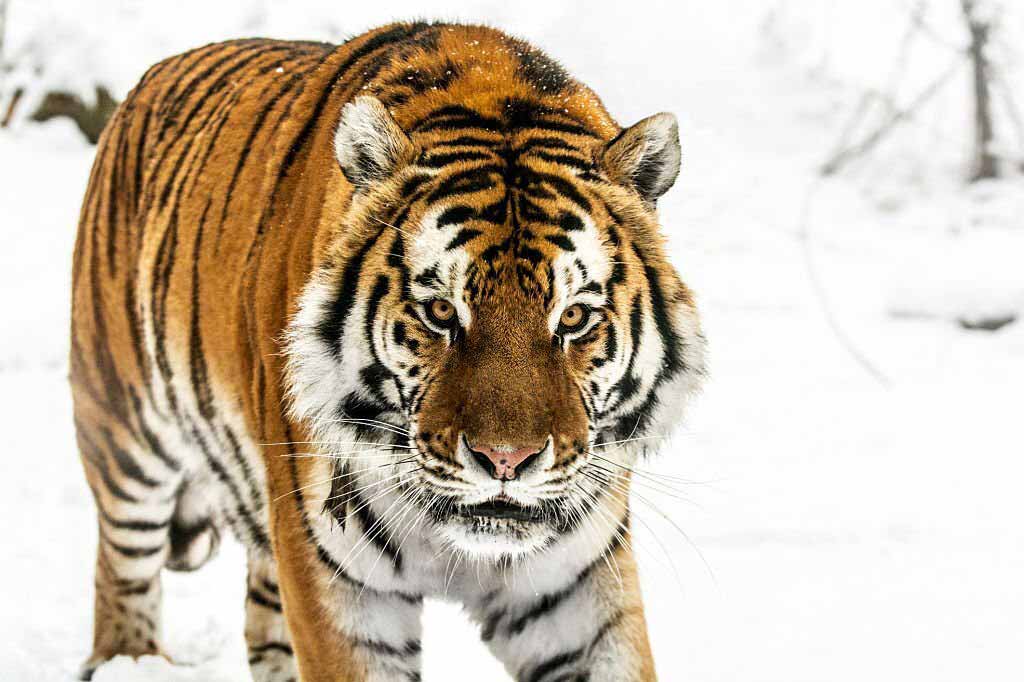
The Siberian or Amur tiger is the largest tiger subspecies or the biggest living cat. It lives in the snowy wilderness of Russia’s Far East and parts of China; these majestic creatures are well-adapted to cold climates.
The Siberian tiger is endangered, with only less than 600 of the population in the wild.
2. The Indo-Chinese Tiger

While entering the jungles of South-East Asia, we encounter the Indo-Chinese tiger. The Indo-Chinese Tiger exudes power and allure, embellished with bold, dark stripes.
A captivating presence in its native habitat, the luxurious coat of the Indo-Chinese tiger is a testament to the beautiful diversity among the true kings of the jungle.
This tiger is also considered endangered, with only 300-400 individuals in the wild.
3. The Bengal Tiger

The list of tiger species will be complete only with the Royal Bengal Tiger. The Bengals found the Indian subcontinent and are respected in the local culture, symbolizing strength and beauty.
The Bengal Tiger has the highest population among other tiger species, around 3000, but still, it’s classified as endangered.
4. The Malayan Tiger

The Malayan tiger is a master of hide-and-seek in camouflage and is found in the lush jungles of the Malay Peninsula. With keen instincts and elusive nature, it’s challenging to glimpse its mysterious world.
The Malayan tiger is also critically endangered, with only around 200-300 individuals remaining in the wild.
5. The Sumatran Tiger
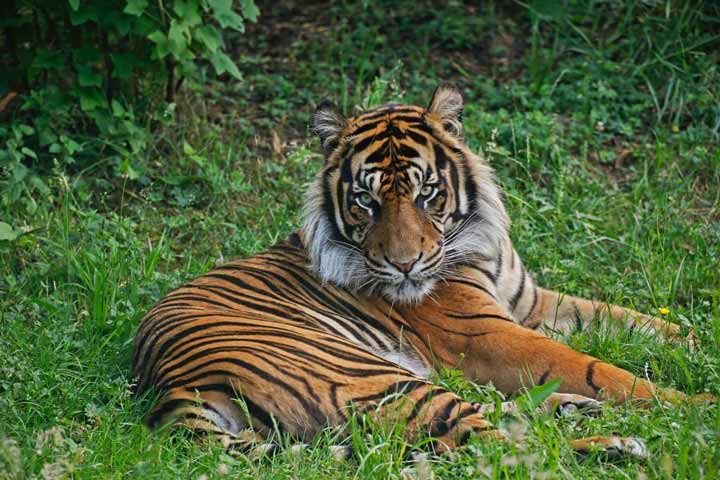
The Sumatran tiger is found only on the Indonesian island of Sumatra. It is small in size and respected in its native habitat. This tiger species is a example of nature’s ability to make diverse and remarkable adaptations.
Unfortunately, the Sumatran tiger population is also critically endangered, with only about 300–400 individuals left in the wild.
6. The South China Tiger
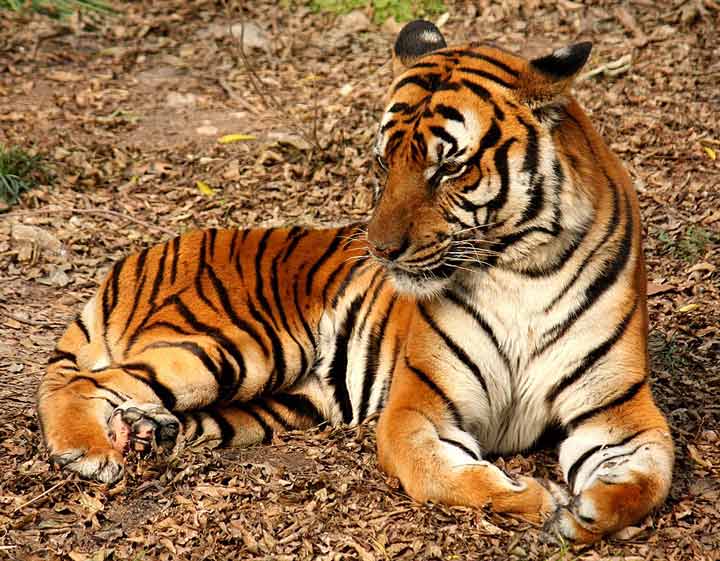
The South China tiger is the rarest tiger subspecies and is found only in captivity.
It is believed that it’s extinct in the wild, as the last confirmed tiger sighting was in the 1990s.
7. The Caspian Tiger

Unfortunately, the Caspian tiger now exists only in memory and historical records. Today we only have traces of its existence survive through preserved specimens and tales of its magnificence.
8. The Bali Tiger

The Bali tiger is native to the Indonesian island of Bali. Tragically, this unique tiger species was declared extinct in the 1940s.
9. The Javan Tiger

The Javan tiger has also been hunted to extinction. Today it only exists in tales of its glorious past in the Indonesian Java island’s jungles.
These three extinct tiger subspecies are a sad reminder of the importance of conservation efforts to protect and preserve the remaining tiger species.
Size and Body Structure
Tigers size and body structure are central to their mystique. The mainland Asian tiger, including the mighty Siberian tiger, is the largest living cat on Earth.
A male Siberian tiger can stretch to an astonishing 3.7 meters (12.1 feet) in length, a size that would dwarf two and a half people lined up end-to-end.
These magnificent creatures, weighing 423 kilograms (933 pounds), are a testament to sheer bulk and power. Males are typically 70% larger than females.
However, their island-dwelling cousins, like the Sumatran tiger, are more petite, maxing out at 140 kilograms (310 pounds) and 2.4 meters (8 feet).
The Bergmann’s law explains the variations in size, which states that animals in colder climates tend to grow larger.
Whether marveling at the colossal Siberian or the more delicate Sumatran, you’re witnessing nature’s incredible adaptation to different environments.

The tiger’s body structure is a marvel of natural engineering, designed to be the ultimate predator. Its canines, up to three inches long, are perfect for penetrating prey.
The claws are razor-sharp and retractable, ready to tear through anything in their path. The mouth, equipped with 30 specialized teeth, is crafted to consume meat with brutal efficiency.
Even the tongue, covered in tiny barbs, serves to strip flesh from bone and doubles as a grooming tool.
The tiger’s muscular build, supported by powerful hind legs and a flexible spine, allows incredible strength and agility. Its eyes are adapted for night vision, and its keen sense of smell constantly guides its next meal.
The distinctive stripes provide camouflage, helping the tiger blend into its surroundings and making each one unique.
This intricate body structure, honed over millions of years, is a testament to nature’s complexity and beauty. It’s a reminder that the tiger is not just a creature to be admired but a symbol of the wild’s untamed majesty.
Color Variation
Tigers are found in many colors. These variations are not just a feast for the eyes; they are intricately linked to their survival, adaptability, and the complex interplay of genetics and environment.
Let’s explore the fascinating world of tiger color variations:
1. The Orange Tiger

The classic and most common coloration, the orange tiger, is adorned with dark, bold stripes that provide perfect camouflage among the dense foliage and grasslands. This coloration is not just a visual spectacle; it’s a survival tool.
The dark stripes break up the tiger’s outline in the forest’s dappled sunlight, allowing them to stalk their prey unseen. The orange hue varies in intensity, depending on the subspecies and the region, adding to the complexity and beauty of this magnificent creature.
2. The White Tiger with Stripes

A rare and breathtaking sight, the white tiger with dark stripes results from a genetic condition called leucism. This gives them a white coat with dark stripes and often blue eyes.
The white tiger’s ethereal beauty has made it a symbol of mystery and power in various cultures. However, this coloration can be a disadvantage in the wild, as it may make them more visible to prey.
The white tiger’s existence reminds us of nature’s ability to surprise and enchant us with its diverse creations. White tigers are mainly in captivity.
3. The Snow White Tiger

Even rarer than the striped white tiger, the full white tiger lacks the dark stripes, resulting in a completely white coat. This extraordinary variation is seldom seen but is a true marvel of nature.
Their existence is a testament to the genetic diversity within the tiger species and a symbol of the delicate balance of nature that allows such rare traits to exist. Full white tigers are extremely rare, and their population is not well-documented.
4. The Golden Tiger

Uncommon and beautiful, the golden tiger has a pale golden hue with faint stripes. This color variation is a marvel of nature, giving the tiger an almost mythical appearance. The golden tiger’s coat reflects the sunlight, adding to its allure and mystique.
This rare coloration is believed to result from a recessive gene and has been observed mainly in captivity. The golden tiger reminds us of the endless possibilities of nature’s creativity and the need to preserve such unique traits.
5. The Black Tiger

A truly rare sight, black tigers have dark coat with even darker stripes. A genetic mutation causes this color variation and has been spotted in the wild, particularly in the Simlipal Tiger Reserve in India.
The black tiger’s coat adds to its mystique and power, symbolizing strength and mystery in various cultures. Their existence is a reminder of the genetic diversity within the tiger species and the importance of conservation efforts to protect such rare and beautiful variations.
6. The Blue Tiger

Also known as the Maltese tiger, the blue tiger is the most mysterious. Reports of blue tigers come mainly from the Fujian Province of China, but no concrete evidence has been found.
The blue hue is believed to result from a recessive gene, and the existence of blue tigers remains a subject of intrigue and speculation.
Sightings have also been reported in Burma and Korea. Some researchers believe the blue tiger may be a subspecies of the South Chinese tiger. Because lack of evidence, many consider them to be creatures of myth.
These color variations are not merely aesthetic; they play a vital role in the tiger’s survival, allowing them to blend into their surroundings and stalk their prey.
They also remind us of the incredible diversity within the animal kingdom and the importance of conservation efforts to preserve these unique and beautiful traits.
Range
Once spread across Asia, from the Pacific Ocean to the Black Sea. Today tigers occupy only seven percent of their historic range. In the last decade alone, their habitat has shrunk by 41%, putting these magnificent creatures in danger of extinction.

But this is not the first time they have faced such alarming circumstances. About 73,000 years ago, massive volcanic eruptions nearly wiped them.
A small group of resilient tigers survived to repopulate the continent, but the population bottleneck resulted in a loss of genetic diversity.
Habitat
Tigers live in various landscapes, from the steamy mangrove swamps of the Sundarbans to the icy forests of Russia’s Far East. They roam in the lush rainforests of Southeast Asia, and even in the rugged terrains of the Himalayas, they find their way.
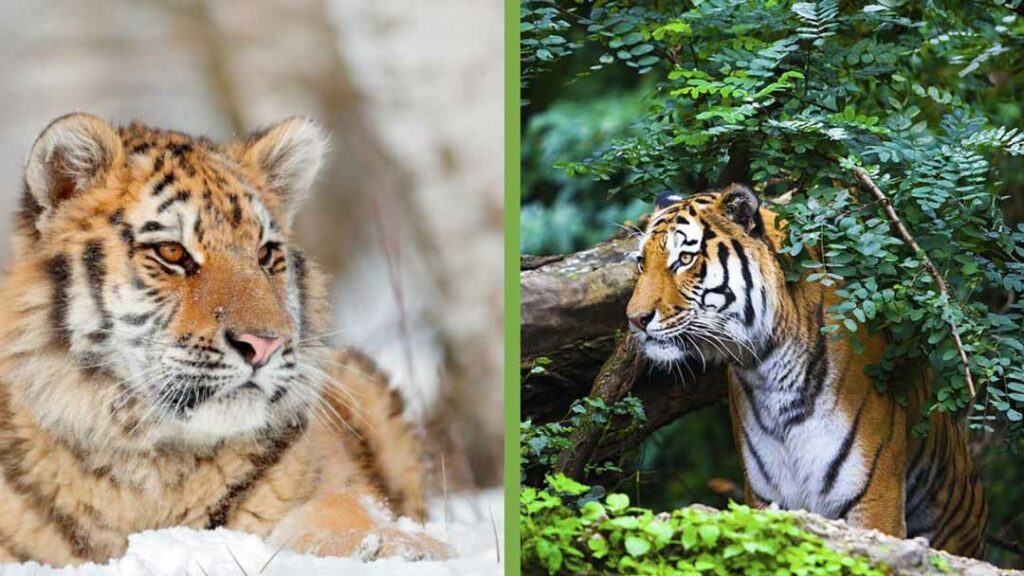
Each of these habitats uniquely shapes the tiger, influencing everything from their hunting techniques to their physical appearance. But these natural homes are under threat, with human encroachment taking a toll. The battle to preserve these habitats is a battle for the very soul of the tiger to keep the wild truly wild.
Diet and Hunting Behavior
Tigers, are skilled hunters that rely more on sight than smell, using their dark striped skin as camouflage among long grass. They sit silently before pouncing on their prey unexpectedly, running from a standstill to 50 mph in short sprints.
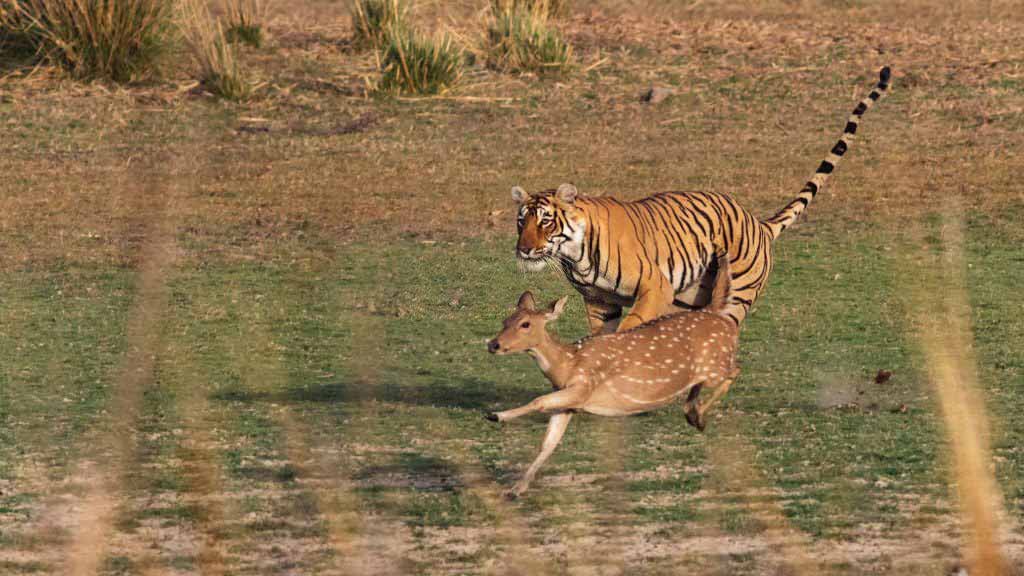
Weighing about 700 lbs, tigers consume 35-110 lbs of meat at a time, typically eating once every two days after feasting on a large mammal.
Their diet includes a wide variety of prey, from large mammals like deer, leopards, boars, and bears to smaller mammals like hares, rodents, frogs, and even insects. If animals are unavailable, they may eat berries or grass to regulate their digestive system.
Tigers prefer hunting on cool or cloudy days, often at sunset, and their night vision is six times better than humans. The method of killing involves a quick bite on the neck to break the bone, followed by ripping the throat out, ensuring a quick and less stressful death for the prey.
Each type of tiger has a different diet based on its geographical location, and there have been incidents where tigers have attacked humans for meat, especially in areas where habitats are lost.
The tiger’s diet and hunting behavior is a testament to its adaptability and intelligence, reflecting its status as one of the apex predators in its ecosystem and emphasizing the importance of conservation efforts to protect these magnificent creatures and their habitats.
Behavior, Reproduction and Longevity
Tigers are solitary creatures, usually only coming together during mating periods. The gestation period is around three to four months; it gives birth to two or four cubs weighing about one kilogram.

Unlike many other cat species, adult tigers provide substantial nourishment to their cubs, often letting them eat before they do. However, there have been instances where males killed the cubs to prompt the mother to mate again.
As young male tigers mature, they establish their territory close to their mothers’ before eventually moving out to find unclaimed territory or challenge older males for theirs.
Tiger territories are vast, with some males having territories spanning up to 294 square kilometers, marked by scent through urine and anal glands to warn other tigers to stay away. Female tiger territories are typically smaller, ranging around 84 square kilometers.
In the wild, a tiger can live up to 15 years, while in captivity, their lifespan can extend to 20 to 25 years, barring any unforeseen circumstances or diseases.
Human Interaction
Tigers’ interactions with humans are a topic of curiosity and concern. While formidable hunters, some older tigers may prey on humans when they can no longer catch other animals.
However, the Sundarbans is an exception, a vast coastal forest along the Ganges Delta in Bangladesh and India, where young and healthy tigers occasionally prey on humans. This has led to approximately 50 deaths each year in the region.
Conservationists have implemented an intriguing tactic to combat this issue. They distribute and wear masks with faces on the back of their heads, creating the illusion that they are always watching the tigers. This clever method has significantly reduced the number of attacks on those wearing masks.
Hybrids
Tiger hybrids result from crossbreeding between different species of big cats.

The most well-known tiger hybrid is the liger, a cross between a male lion and a female tiger and can grow the largest of all big cats. The tigon, produced by a male tiger and a female lion, is another remarkable hybrid.
These hybrids frequently combine qualities from both parent species, physically and behaviorally. It’s important to remember that tiger hybrids are produced in captivity and may experience health issues and shorter lifespans.
They also bring up moral issues with breeding methods and the abuse of these magnificent animals for profit. Tiger hybrids remind us of the intricacy of big cat genetics and the implications of human breeding intervention.
Conservation and Threats
Once ruling vast landscapes across Asia, the tiger now finds itself cornered in the face of relentless threats. The decline has been staggering, from an estimated 100,000 tigers at the beginning of the 20th century to fewer than 5,000 today.
This steep drop results from a combination of factors that have converged to push this iconic species to the brink.

Threats
1. Poaching: The illegal trade in tiger parts, including skin, bones, and other body components for traditional medicine and decorative purposes, continues to be a significant threat. Despite international bans, the demand persists, driving relentless poaching.
2. Habitat Loss: Urbanization, deforestation, and conversion of wild lands into agricultural fields have led to a loss of 93% of the tiger’s historical range. This fragmentation isolates populations and makes survival increasingly precarious.
3. Human-Tiger Conflict: Conflicts arise as human settlements expand into tiger territories. Tigers preying on livestock lead to retaliatory killings, further dwindling their numbers.
4. Climate Change: Rising sea levels and changing weather patterns threaten the unique ecosystems where some tiger subspecies live, such as the Sundarbans mangroves.
Conservation
1. Legal Protection: Many countries have enacted laws to protect tigers and their habitats. International agreements also seek to curb the trade in tiger parts.
2. Reserves and Sanctuaries: Protected areas have been established to provide safe havens for tigers. Anti-poaching teams often patrol these reserves.
3. Community Engagement: Conservation efforts increasingly involve local communities in protecting tigers, recognizing that their survival is intertwined with local livelihoods and cultural values.
4. Scientific Research: Ongoing research using radio collars and camera traps helps understand tiger behavior, track their movements, and develop effective conservation strategies.
5. Global Initiatives: Organizations like WWF and governments were working together on ambitious plans to double the number of wild tigers by 2022 through the Tx2 initiative. As of 2023, progress is being assessed, and the commitment to tiger conservation remains strong.
Global Wild Tiger Population
| Country | Year | Estimate |
|---|---|---|
| India | 2023 | 3167 |
| Russia | 2016 | 433 |
| Indonesia | 2016 | 371 |
| Bangladesh | 2014 | 300–500 |
| Nepal | 2022 | 355 |
| Thailand | 2016 | 189 |
| Bhutan | 2015 | 89–124 |
| Malaysia | 2014 | 80–120 |
| China | 2018 | 55 |
| Myanmar | 2018 | 22 |
| Laos | 2016 | 14 |
| Vietnam | 2016 | <5 |
| Cambodia | 2016 | 0 |
| Total | 4,744–5,074 |
The path to saving the tiger is fraught with challenges, but the efforts are relentless. The tiger is a symbol of wild majesty and a keystone species whose survival impacts entire ecosystems.
The fight for the tiger is a fight for the soul of the wild, a battle humanity must not lose. The time to act is now, for the tiger’s roar must not be silenced forever.
Conclusion
In the heart of the dense forests, the kings of the animal kingdom roam with power and magnificence. However, their royal presence is under threat, and we must act fast to protect these captivating creatures for generations to come. By understanding their classification, size, hunting behavior, and unique adaptations, we gain a deeper appreciation for the wonders of tigers.
Let us unite to ensure that these magnificent big cats continue to rule their territories undisputed and revered as the true kings of the jungle. Through conservation efforts, responsible practices and raising awareness, we can secure a future where tigers will thrive and continue to mesmerize us with their wild beauty and indomitable spirit.
The fate of these majestic creatures lies in our hands, and now the time has come to protect their kingdom – the forests they call home. Together, we can preserve the reign of the true kings – the tigers.
FAQs
A tiger is a large, carnivorous feline with a distinctive orange coat marked with black stripes. It has a muscular build, powerful jaws, sharp claws, and eyes adapted for night vision. Known for its strength, agility, and solitary nature, the tiger is both revered and feared as one of the apex predators in the wild.
A tiger is incredibly powerful, with the ability to take down prey much larger than itself. Its muscular body, strong legs, and powerful jaws enable it to hunt and kill animals like deer, buffalo, and even young elephants. The tiger’s strength and agility make it one of the most formidable predators on Earth.
Tigers’ primary weaknesses are their dependence on specific habitats and prey availability. Habitat loss, human conflict, and poaching are significant threats to their survival. Additionally, their solitary nature can make them more vulnerable to human threats.
Tigers are famous for their beauty, strength, and grace. They are symbols of power and courage in various cultures and are often featured in myths, folklore, and literature. Their distinctive appearance and behavior have made them subjects of fascination and admiration worldwide.
The tiger is the national animal of India due to its rich symbolic significance in Indian culture. It represents power, strength, elegance, and courage. The tiger also plays a vital role in India’s ecosystems, and its status as a national symbol emphasizes the importance of wildlife conservation.
Majestic, powerful, graceful, mysterious, solitary, fierce, agile, endangered, symbolic, beautiful.
The tiger’s majestic stride and distinctive striped coat symbolize both the beauty and the raw power of the wild, making it a revered creature in cultures around the world.




